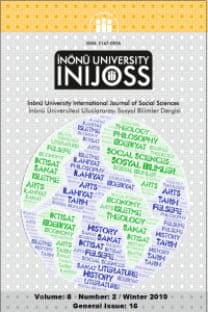FROM A JOURNEY OF INNER STRUGGLE TO A CATASTROPHE: ^ HENRIK IBSEN’S HEDDA GABLER
Hedda Gabler, Henrik Ibsen, maternity, female roles.
___
1. CIXOUS, Hélène and Catherine Clément: The Newly Born Woman, I. B. Tauris Publishers: London, 1996.2. de BEAUVOIR, Simone. The Second Sex. H. M. Parshley, (Trans.and Ed.), New York: Penguin Books Ltd., 1977.
3. “Dionysus.” Henrik Ibsen, Hedda Gabler. http://academic.brooklyn.cuny.edu/english/melani/cs6/ dionysus.html.April 23, 2009.
4. FINNEY, Gail. Women In Modern Drama: Freud, Feminism, and European Theatre at the Turn of the Century. Cornell University Press: Ithaca and London, 1989.
5. FREUD, Sigmund. “Female Sexuality” (1931). Sexuality and the Psychology of Love, Philip Rieff (Ed.). New York: Collier Books, 1970. 194-211.
6. GILBERT Sandra M.&Susan Gubar. The Madwoman in the Attic: The Woman Writer and 7. The Nineteenth-Century Literary Imagination. New Haven and London: Yale University Press, 1984.
8. GOODMAN, Randolph G.. From Script to Stage: Eight Modern Plays. San Francisco: Rinehart Press, 1971.
9. HARDWICK, Elizabeth. Seduction and Betrayal: Women and Literature. New York: Random House, 1970.
10. IBSEN Henrik. Hedda Gabler. The Norton Introduction to Literature (Eds.) Carl E. Bain, Jerome Beaty, J. Paul Hunter. 6th ed., New York and London: W. W. Norton&Company, 1995.
11. ……… Henrik. A Doll’s House. Penguin Classics: New York, 2003.
12. KILDAHL, Erling E., “The Social Conditions and Principles of Hedda Gabler.” Educational Theatre Journal, Vol. 13, No: 3, An Issue Devoted to Modern Drama (Oct., 1961), pp. 07-213., The John Hopkins University Press, http://www.jstor.org./stable/3204828. Accessed: 03-04-2015.
13. MAYERSON, Caroline W. “Thematic Symbols in Hedda Gabler.” Rolf Fjelde (Ed.) Ibsen: A Collection of Critical Essays. Englewood Cliffs: Prentice Hall, 1965, 131-138.
14. McFARLANE, James Walter (Ed.), The Oxford Ibsen. London: Oxford University Press, 1966.
15. NILSEN, Havard. “How Ibsen Found His Hedda Gabler.” Ibsen Studies. Vol. 3, Issue 1, June, 2003. pp. 7-31.
16. SHOWALTER, Elaine. The Female Malady: Women, Madness, and English Culture, 1830- 1980. London: Virago Press, 1985.
- ISSN: 2147-0936
- Yayın Aralığı: Yılda 2 Sayı
- Yayıncı: İnönü Üniversitesi
CLASS AND SOCIAL IDENTITY IN WILL SELF’S BETWEEN THE CONCEITS
DUAL NATURE OF VIOLENCE AND DIVIDED SELF OF MAN IN THE POEMS OF TED HUGHES
ECOLOGICAL CITIZENSHIP IN THE POEMS BY JOY HARJO
NATURE, CRITICISM OF THE WORLD, AND LOVE IN “DOVER BEACH” AND “LOVE AMONG THE RUINS”
REFLECTIONS OF CULTURAL CONCEPTION OF SELF IN ZADIE SMITH’S THE AUTOGRAPH MAN
FICTION OR PRECONCEPTION: THE ‘APE’ ALLEGORY IN ROSE MACAULAY’S THE TOWERS OF TREBIZOND
A KOHUTIAN APPROACH TO “A BIT OF SINGING AND DANCING” BY SUSAN HILL
EDMUND BURKE: “REFLECTIONS ON THE REVOLUTION IN FRANCE”1
DISEMPOWERED ‘OTHERS’ AND THE FEMALE SOLIDARITY IN SUE TOWNSEND’S BAZAAR AND RUMMAGE (1982)
